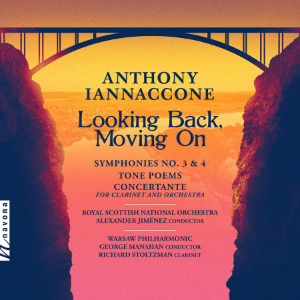
Anthony Iannaccone (b. 1943)
Looking Back, Moving On
Symphony No. 3 Night Rivers (1992)
Symphony No. 4 Bridges (2019)
Waiting for Sunrise on the Sound (1998)
Concertante for Clarinet and Orchestra (1994)
From Time to Time – Fantasias on two Appalachian Folksongs (1994)
Richard Stoltzman (clarinet)
Royal Scottish National Orchestra/Alexander Jiménez
Warsaw Philharmonic/George Manahan (Concertante)
rec. 2022, Glasgow Royal Concert Hall (except Concertante)
Navona NV6487 [2 CDs: 90]
Anthony Iannaccone’s academic roots are to be found in the Manhattan School of Music and the Eastman School. His principals were Vittorio Giannini, Aaron Copland, Samuel Adler and David Diamond. During the 1960s, he supported himself as a part-time teacher (Manhattan School of Music) and orchestral violinist. Over three decades at Eastern Michigan University, Iannaccone founded an electronic music studio, taught composition and conducted the Collegium Chamber Orchestra and Chorus.
Across one hour and thirty minutes of this Navona set we get to hear five orchestral works – two symphonies, a concerto and various ‘tone poems’ – written over a 25-year period. Despite the two recording venues and two orchestras the sound is uniformly fine with no “crashing of gears”. The music itself is forwardly recorded, unapologetically so.
Without being soporific, Iannaccone has a gift, whether in calm or in storm, for aureate radiance. Remember the metallic gods in Walton’s Belshazzar’s Feast? Well, think, in this case, of gold and silver – especially gold. Everything is played here with exciting virtuosity. The mastery of the RSNO brass, who embrace their many opportunities, is asserted time after time: “Praise ye! The God of Gold!” At the other pole, and just as much one of Iannaccone’s salient hallmarks, this composer has a ‘weakness’ for gently pealing and glowingly bell-like strings.
There are four Iannacone symphonies. The first two date from the 1960s: Nos. 1 Passage to Whitman (1965) and 2 (1966); I hope to hear them one day. The Third, in one movement, is entitled Night Rivers. It has been recorded three times already. A high-chiming sunrise of an idea contrasts with deeper tones and an intense dazzle. Clouds form and part, and the orchestral impasto thins to a few instruments including solo violin and piano. Virtuoso writing and playing shades into something less demonstrative and more stoical. Iron-shod and rolling combers of brass punch home. The RSNO benches and Navona’s engineers are more than equal to the resulting demands. At the close a glistening violin fades the listener into silence. The score is packed, shoulder to cramped shoulder, with exciting incident. As for cohesion, the jury’s out and I am still working towards assimilation of a work whose episodes I find riveting.
The ‘Bridges’ of the Symphony No. 4 bespeak leaps of faith as well as crossing physical chasms. There are three movements. The first, ‘Bold Advance, Heavy Toll – A Rhine bridge too far’, prepares you for a work of struggle and superhuman achievement. Heavy brawling brass topped off boisterously with a hint of Shostakovich-like percussion bring out, at one moment, an aggressive triumphalist acidity, and at another a glistening nobility. The orchestration is lustrous and amid the emotional hurly-burly there is room for tender romance on the recoil from all that attack. After the contrast of ‘Imagination and Endurance – Roeblings’ dream bridge grows in Brooklyn’, comes the third and last movement ‘Be Strong – Steel Emblems Vault the Channel: The Verrazano’. This might well recall, for you, the indefatigably pounding motifs of William Alwyn’s Fourth Symphony. There is a striving for victory here and an element of disillusion that suggests the composer has not found repose. Again there is excellent work from Alexander Jiménez who also conducted the Florida premiere of this work.
The 1998 work, Waiting for Sunrise on the Sound, trails and blends memories of storm and childhood fears. Tendrils of awe and fear alternate with a thoughtful element. A slow dripping sunset is threaded with celebration and trickling springs of what feels like hope. The second disc presents the Concertante for Clarinet and Orchestra (1994). There is a pristine chill in the air and thunderous hammerheads ruckle the skyline. Solo instruments – violin and chiming sounds – entwine like ivy. This build-up of tension gives way to imperious shudders and much writing that is essentially lyrical and nostalgic; a bit like Finzi. An idyllic sunset ‘drizzle’ asserts itself but finally gives way to whoopingly urgent Americana. The clarinet of Richard Stoltzman voices and enhances this score. Almost a decade later Iannaccone wrote a Clarinet Quintet for the same musician.
Finally we hear From Time to Time – Fantasias on two Appalachian Folksongs (2000). The first of these ‘Once Upon a Time’ is rife with the sound and shudder of victory. There is about it a crash of conflict and of the beating of great wings recalling Nike’s winged victory. The composer revels in the beloved song ‘Shenandoah’ and makes inventive and touching use of this material. The second – and shorter – Fantasia is ‘Moving Time’. This lifts the spirits with some brusquely ripe brass but it is the first Fantasia that holds the attention and the heart.
The liner booklet uses white characters on black foreground. This makes it difficult to read. The notes by Lucy Murray are, however, good and well worth peering at.
Rob Barnett
Help us financially by purchasing from




















